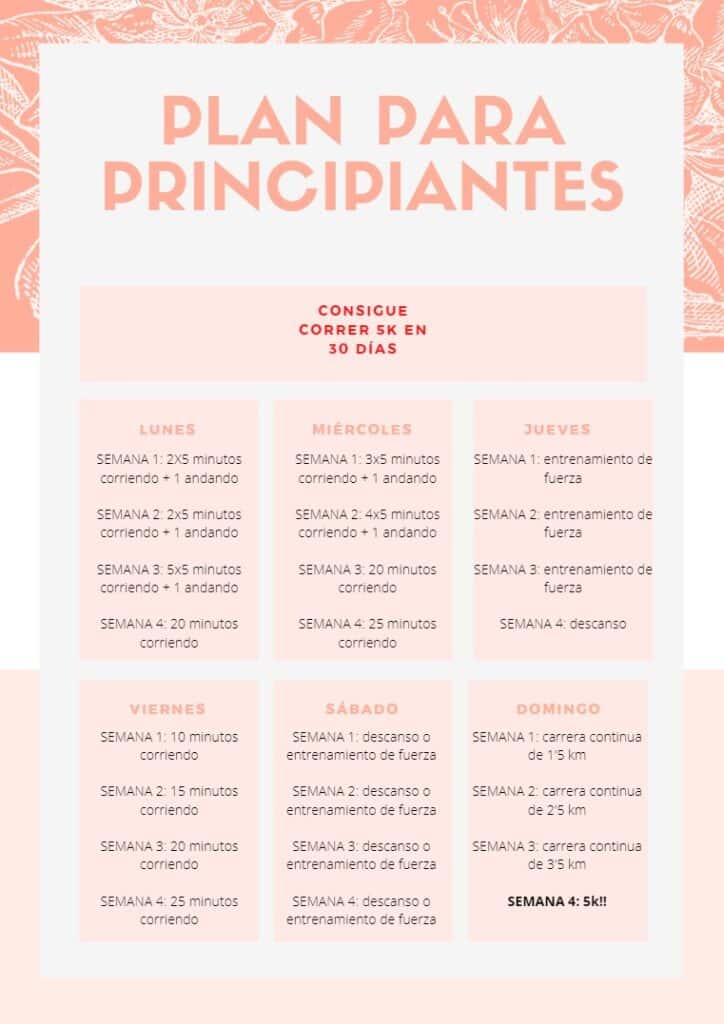
You have started running. It feels good. Maybe a little difficult, but you like the idea of stretching your legs and uploading a photo to your social networks. You even plan to sign up for a short distance race. Good choice! The 5K is a good distance for both beginners and established athletes. It's fun and doable, and if you've been walking, running, or alternating two to three days a week for at least two months, you're all set.
Sure, increasing your mileage will feel hard, and there will be days you don't feel like running, but the payoff is real, and not just the sweaty T-shirt. The training itself pays back: you'll feel fitter and stronger and you'll be surprised that a distance or pace that used to be difficult actually feels comfortable.
Your first step is to sign up for a race that is at least five weeks away. This will give you enough time to follow the training program that we show you below.

A 5K Training Plan for Beginners
Your goal is to finish your first 5K. You'll feel like you're ready if you've been running, walking, or alternating both two to three days a week for at least two months.
What is the running plan?
There are four race days, with a rest or cross-training day in between. The every other day schedule minimizes the risk of injury and provides a mental break. Rotating days also ensures that your days off fall on weekdays and weekends, so the plan can accommodate your work and home life.
It is best to follow the plan perfectly, without trying to change the days in order or skip the progression for missing a day. It is essential to continue increasing minutes progressively. Although we have the feeling of being able to increase more minutes one day, it is convenient to do it according to the running plan.
time vs kilometers
It's easier to time your runs than it is to time your mileage, so weekday workouts are done by the clock. Sunday's run is in kilometers so you can start to get an idea of your pace per kilometer. Trainings of this type are also confidence builders. Knowing how far you've run offers the assurance that you can cover the distance on race day.
No need to get hung up on numbers. It is convenient to listen to the body and progress in the adaptation until you can endure running for several minutes in a row. As the weeks go by, the race time will improve.
Heating/Cooling
Each run begins with five minutes of brisk walking and ends with five minutes of easy walking. You'll be tempted to skip this, but don't! Warming up and cool down safely gets your body in and out of exercise. They also increase your overall training time, which helps build the stamina you'll need on race day.
In both moments, the race should not be explosive or intense. It is about activating and relaxing the muscles, not taking them to a training extreme. Jog for a few minutes and then improve speed in the running session.

How to use this training calendar?
Once you have your training calendar printed and posted somewhere you'll look at it every day to remind yourself to stay on track, you'll want a little idea of how to apply all these workouts to your daily routine. Here's a breakdown of the main types of workouts and some tips for getting the most out of your workout.
intensity/pace
All runs should be done with easy effort: a talk pace, 60 to 65 percent of maximum heart rate, or a 5 on a scale of perceived excursion rate (1 to 10). Running faster and harder increases your risk of injury. Use your first run to build stamina, and then if you want you can start playing with speed.
However, as it is a running plan for beginners, it is recommended to go slowly and calmly. As we gain experience and confidence, we will be able to increase the intensity and pace of the race.
Run walk
For the first two weeks, workouts alternate running with one minute of walking. So "2 x 5 minute run, 1 minute walk" means you'll run for 5 minutes, walk for 1, then repeat. Similarly, "3 x 5" means you do it three times.
Don't view walking breaks as a weak proposition. Nearly 80 percent of runners are injured, and walking breaks are a strategic tool for building distance safely. Plus, they make adjusting to running easier and more fun.
Easy run and long run
Easy run workouts are steady runs done at a comfortable pace. If you're having a hard time finishing your workout, slow down.
Instead, long runs build the foundation of distance running: endurance. They are the most important training for road runners. If you don't live near a walking trail that has miles marked on it, measure the distance with Google Maps or use a mileage app.
Rest/Cross Training
Rest days are days off (no training). Cross training is an option. You can do yoga, swim, bike, go to the gym, or any other exercise you enjoy. Extra exercise will boost your run, just make it easy the day before your long run so you don't start this key workout fatigued.
However, total rest is very necessary for the muscles to fully recover. In the case of beginners, their muscles are not used to so much pressure and activity. Therefore, it is recommended to make days of total rest and sleep properly at night.
Weekdays
Plans change sometimes. If you need to rearrange your training days, do so. Simply shift the days forward or backward, or do your best to stick to the every other day schedule.
However, do not change the order or skip the days set. If you can't train three days in a row, start where you left off. It is not recommended to do a three-day jump because our body will not have adapted correctly and will not notice a progression.